 TIME
TIME
FOR KIDS
EXPLORERS
ROBOTS By Mark Shulman
and
James Buckley Jr. Contents The Robots Are Coming  Not very long ago, robots were a fantasy of storybooks. Fictional robots could be our perfect servants, giving us freedom to zoom in our space cars,... or they could take over the world with their sub-atomic pulsing laser cannons. In real life, robots help build our cars and they vacuum our floors. (Thats even better.) Robots today help doctors perform surgery, and help people walk again. (Now youre talking.) Modern robots are even sent in to fight fires, catch crooks, deal with bombs, and save lives. (Awesome!) Of course, robots can also spy on you from the sky, beat you in chess, and eventually be a whole lot smarter than you are. (Um, wait a minute.) The fact is, robots are getting smarter, stronger, and more agile, and theyre going to be everywhere. (Um, wait a minute.) The fact is, robots are getting smarter, stronger, and more agile, and theyre going to be everywhere.
Not very long ago, robots were a fantasy of storybooks. Fictional robots could be our perfect servants, giving us freedom to zoom in our space cars,... or they could take over the world with their sub-atomic pulsing laser cannons. In real life, robots help build our cars and they vacuum our floors. (Thats even better.) Robots today help doctors perform surgery, and help people walk again. (Now youre talking.) Modern robots are even sent in to fight fires, catch crooks, deal with bombs, and save lives. (Awesome!) Of course, robots can also spy on you from the sky, beat you in chess, and eventually be a whole lot smarter than you are. (Um, wait a minute.) The fact is, robots are getting smarter, stronger, and more agile, and theyre going to be everywhere. (Um, wait a minute.) The fact is, robots are getting smarter, stronger, and more agile, and theyre going to be everywhere.
Inside this fascinating book, youll get to see the latest and most interesting robots that exist today. And youll find them in all kinds of places: in the sky, at home, in the science lab, and on the front lines. T IME FOR K IDS Explorers : Robots uses dazzling photos, fun facts, and a bright, electric presentation to give you the very latest on bright, electric robots. Robots are working for us in many new and exciting ways. Find out what you can expect in the near future from our helpful, diligent, loyal robot servants. And heres hoping they stay that way! Because the robots arent just coming...
Theyre already here! This book explores the incredible world of robots. 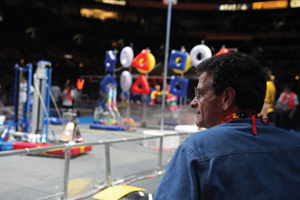 Previous generations could only dream about these exciting machines, or maybe see them in comic books or movies. But today, real robots are everywhere. They build our cars, clean our houses, help our soldiers, and even perform medical surgery. I hope the facts in this book amaze you as much as they do me. I look at all of these beautiful, sophisticated machines and say to myself, If this is what we can do today, who knows what we will do tomorrow? Remember, part of this books title is Explorers.
Previous generations could only dream about these exciting machines, or maybe see them in comic books or movies. But today, real robots are everywhere. They build our cars, clean our houses, help our soldiers, and even perform medical surgery. I hope the facts in this book amaze you as much as they do me. I look at all of these beautiful, sophisticated machines and say to myself, If this is what we can do today, who knows what we will do tomorrow? Remember, part of this books title is Explorers.
I hope these pages will inspire you to be curious, to discover new ways of doing things, and to make your ideas a reality even if people say they cant be achieved. Robots and all of the other fantastic machines in our world are the results of people just like you who dreamed of extraordinary things and asked, Why not? Dean Kamen Founder, FIRST Robotics The FIRST Robotics Competition is an annual international high school robotics competition. Six Degrees of Robots Different kinds of robots do different kinds of jobs. Whatever the job, robots are built to make life easier, save lives, and may someday even look alive. Which robot for which job? Nearly all the robots we can imagine fall into one of the following six categories, ranging from human-controlled to self-controlled to robots that can think for themselves. Tele-robot 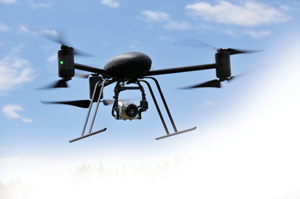 Humans control the movements of these robots via remote control.
Humans control the movements of these robots via remote control.
Telepresence 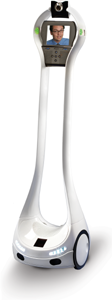 Like tele-robots, these are run by remote control. But telepresence robots have cameras that communicate what the robot sees and hears to the operator. Static
Like tele-robots, these are run by remote control. But telepresence robots have cameras that communicate what the robot sees and hears to the operator. Static 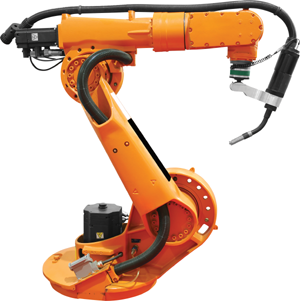 These industrial robots are the most simple independent robots. Once theyre programmed, they dont need humans to operate. Static means they dont travel, but they do swing their arms around to build and handle materials. Mobile
These industrial robots are the most simple independent robots. Once theyre programmed, they dont need humans to operate. Static means they dont travel, but they do swing their arms around to build and handle materials. Mobile  Robots that can move on their own are mobile.
Robots that can move on their own are mobile.
They use preprogrammed routes or they read their environment and steer themselves. Autonomous 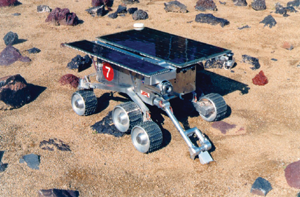 These can move on their own, take in energy from the environment, and change their actions to fit the task. There are very few of these advanced robots. Android
These can move on their own, take in energy from the environment, and change their actions to fit the task. There are very few of these advanced robots. Android 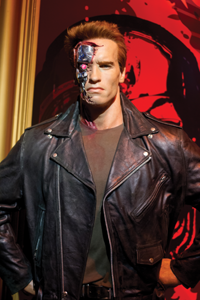 These are robots that are designed to look and act like humans. The photo shows a statue of actor Arnold Schwarzenegger playing an android in the movie The Terminator . Isaac Asimovs Three Laws of Robotics
These are robots that are designed to look and act like humans. The photo shows a statue of actor Arnold Schwarzenegger playing an android in the movie The Terminator . Isaac Asimovs Three Laws of Robotics 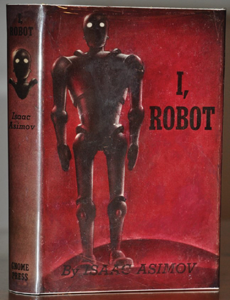 Isaac Asimov was a popular science fiction author who wrote many stories involving robots, including I, Robot.
Isaac Asimov was a popular science fiction author who wrote many stories involving robots, including I, Robot.
In 1942, Asimov introduced his now-famous Three Laws of Roboticsthe ironclad laws that iron giants must absolutely follow. The Three Laws are: 1. A robot may not injure a human being or, through inaction, allow a human being to come to harm. 2. A robot must obey the orders given to it by human beings, except where such orders would conflict with the First Law. 3.
A robot must protect its own existence as long as such protection does not conflict with the First or Second Law. Exploring Robots in History People have dreamed of making mechanical human beings for centuries. The great Italian artist Leonardo da Vinci drew up plans for a machine that looked like a knight. The novel Frankenstein was about a scientist making a man into a living machine. Those dreams began to come true in the 20th century. 1900 Automatic Man 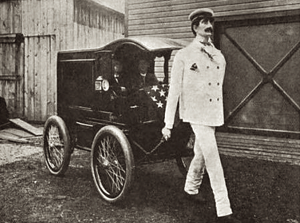 This human-like machine was designed by New Yorker Louis Perew to pull a carriage. 1900 Automatic Man
This human-like machine was designed by New Yorker Louis Perew to pull a carriage. 1900 Automatic Man  This human-like machine was designed by New Yorker Louis Perew to pull a carriage.
This human-like machine was designed by New Yorker Louis Perew to pull a carriage.
It ran on an electric battery and was one of several attempts by early designers to create machines that worked and looked like people. 1914 Tik-Tok of Oz 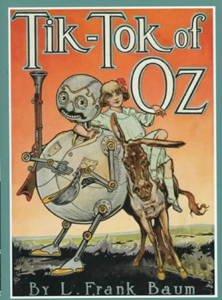 Fiction inspired the ideas of robot makers. Author L. Frank Baum introduced the roly-poly Tik-Tok character in his Oz series. Though Tik-Tok wasnt called a robot in the story, this mechanical man is considered to be the first bot to appear in literature. 1920 First Robot
Fiction inspired the ideas of robot makers. Author L. Frank Baum introduced the roly-poly Tik-Tok character in his Oz series. Though Tik-Tok wasnt called a robot in the story, this mechanical man is considered to be the first bot to appear in literature. 1920 First Robot 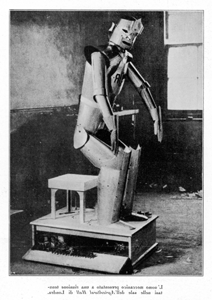
Next page
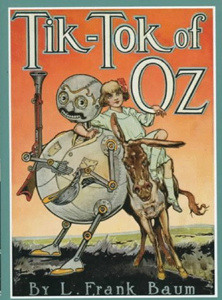
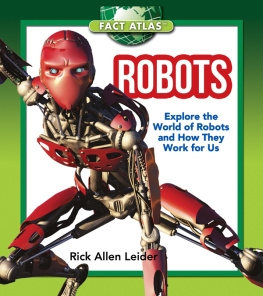
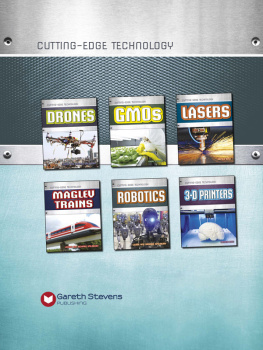
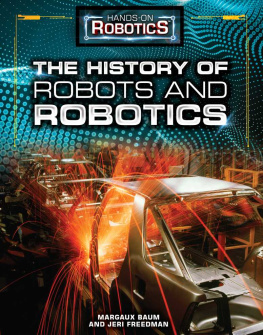



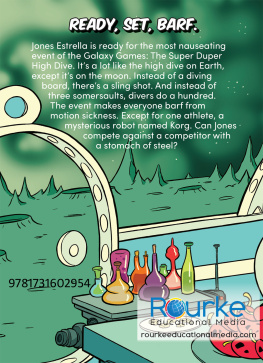
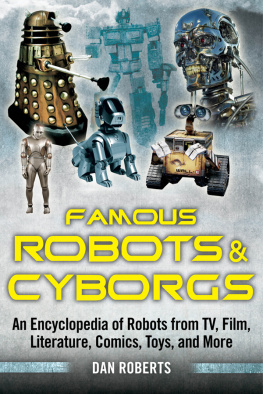
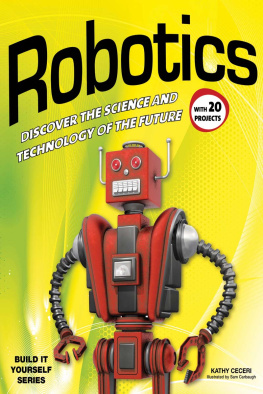
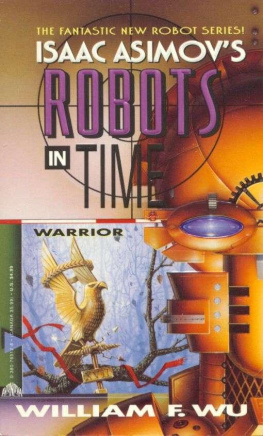
 TIME
TIME Not very long ago, robots were a fantasy of storybooks. Fictional robots could be our perfect servants, giving us freedom to zoom in our space cars,... or they could take over the world with their sub-atomic pulsing laser cannons. In real life, robots help build our cars and they vacuum our floors. (Thats even better.) Robots today help doctors perform surgery, and help people walk again. (Now youre talking.) Modern robots are even sent in to fight fires, catch crooks, deal with bombs, and save lives. (Awesome!) Of course, robots can also spy on you from the sky, beat you in chess, and eventually be a whole lot smarter than you are. (Um, wait a minute.) The fact is, robots are getting smarter, stronger, and more agile, and theyre going to be everywhere. (Um, wait a minute.) The fact is, robots are getting smarter, stronger, and more agile, and theyre going to be everywhere.
Not very long ago, robots were a fantasy of storybooks. Fictional robots could be our perfect servants, giving us freedom to zoom in our space cars,... or they could take over the world with their sub-atomic pulsing laser cannons. In real life, robots help build our cars and they vacuum our floors. (Thats even better.) Robots today help doctors perform surgery, and help people walk again. (Now youre talking.) Modern robots are even sent in to fight fires, catch crooks, deal with bombs, and save lives. (Awesome!) Of course, robots can also spy on you from the sky, beat you in chess, and eventually be a whole lot smarter than you are. (Um, wait a minute.) The fact is, robots are getting smarter, stronger, and more agile, and theyre going to be everywhere. (Um, wait a minute.) The fact is, robots are getting smarter, stronger, and more agile, and theyre going to be everywhere. Previous generations could only dream about these exciting machines, or maybe see them in comic books or movies. But today, real robots are everywhere. They build our cars, clean our houses, help our soldiers, and even perform medical surgery. I hope the facts in this book amaze you as much as they do me. I look at all of these beautiful, sophisticated machines and say to myself, If this is what we can do today, who knows what we will do tomorrow? Remember, part of this books title is Explorers.
Previous generations could only dream about these exciting machines, or maybe see them in comic books or movies. But today, real robots are everywhere. They build our cars, clean our houses, help our soldiers, and even perform medical surgery. I hope the facts in this book amaze you as much as they do me. I look at all of these beautiful, sophisticated machines and say to myself, If this is what we can do today, who knows what we will do tomorrow? Remember, part of this books title is Explorers. Humans control the movements of these robots via remote control.
Humans control the movements of these robots via remote control. Like tele-robots, these are run by remote control. But telepresence robots have cameras that communicate what the robot sees and hears to the operator. Static
Like tele-robots, these are run by remote control. But telepresence robots have cameras that communicate what the robot sees and hears to the operator. Static  These industrial robots are the most simple independent robots. Once theyre programmed, they dont need humans to operate. Static means they dont travel, but they do swing their arms around to build and handle materials. Mobile
These industrial robots are the most simple independent robots. Once theyre programmed, they dont need humans to operate. Static means they dont travel, but they do swing their arms around to build and handle materials. Mobile  Robots that can move on their own are mobile.
Robots that can move on their own are mobile. These can move on their own, take in energy from the environment, and change their actions to fit the task. There are very few of these advanced robots. Android
These can move on their own, take in energy from the environment, and change their actions to fit the task. There are very few of these advanced robots. Android  These are robots that are designed to look and act like humans. The photo shows a statue of actor Arnold Schwarzenegger playing an android in the movie The Terminator . Isaac Asimovs Three Laws of Robotics
These are robots that are designed to look and act like humans. The photo shows a statue of actor Arnold Schwarzenegger playing an android in the movie The Terminator . Isaac Asimovs Three Laws of Robotics  Isaac Asimov was a popular science fiction author who wrote many stories involving robots, including I, Robot.
Isaac Asimov was a popular science fiction author who wrote many stories involving robots, including I, Robot. This human-like machine was designed by New Yorker Louis Perew to pull a carriage. 1900 Automatic Man
This human-like machine was designed by New Yorker Louis Perew to pull a carriage. 1900 Automatic Man  Fiction inspired the ideas of robot makers. Author L. Frank Baum introduced the roly-poly Tik-Tok character in his Oz series. Though Tik-Tok wasnt called a robot in the story, this mechanical man is considered to be the first bot to appear in literature. 1920 First Robot
Fiction inspired the ideas of robot makers. Author L. Frank Baum introduced the roly-poly Tik-Tok character in his Oz series. Though Tik-Tok wasnt called a robot in the story, this mechanical man is considered to be the first bot to appear in literature. 1920 First Robot 